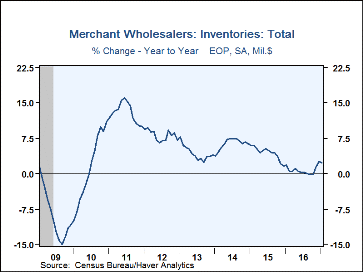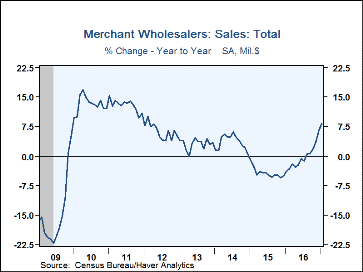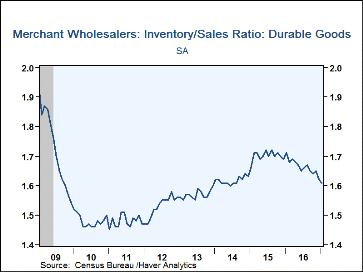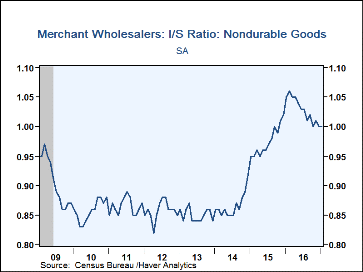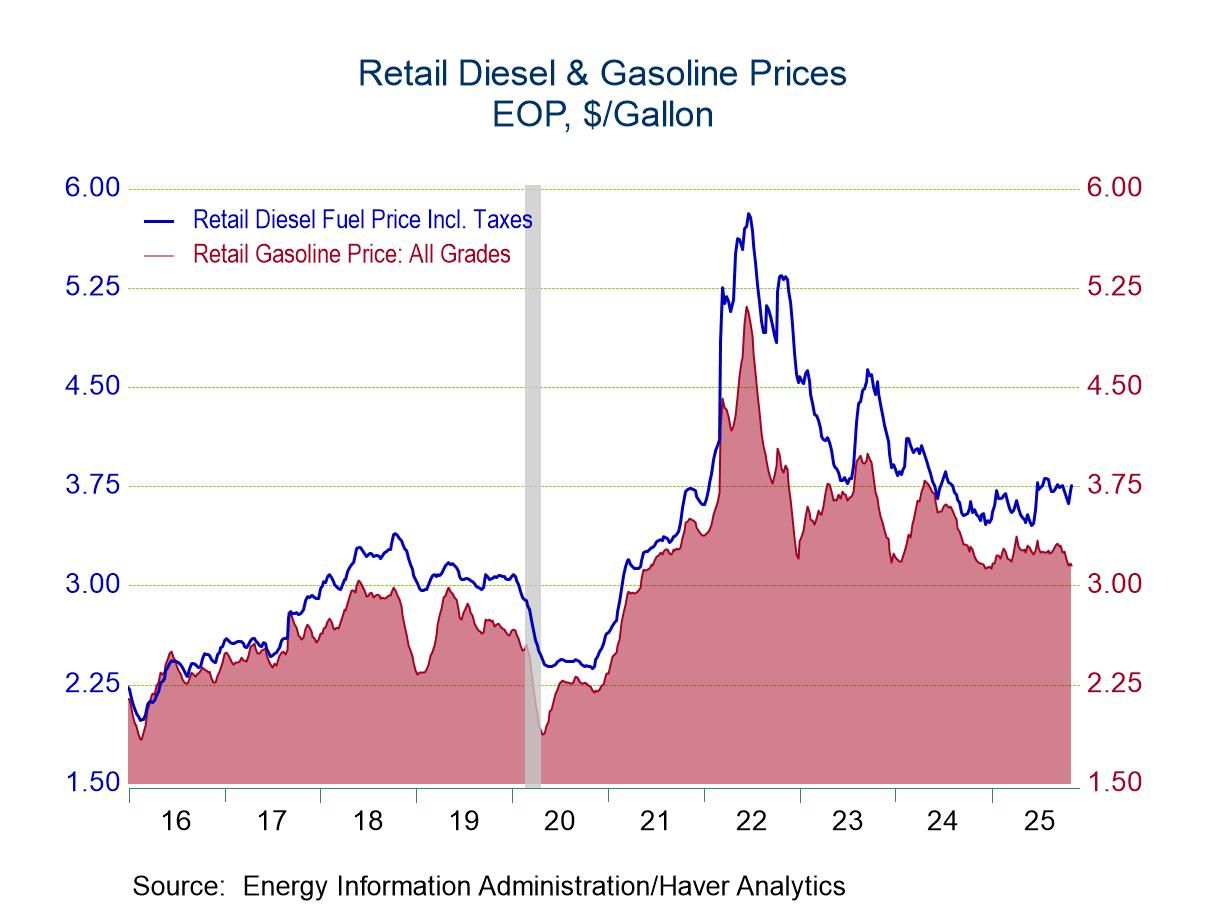 Global| Mar 08 2017
Global| Mar 08 2017Wholesale Sales & Inventories Decline
by:Tom Moeller
|in:Economy in Brief
Summary
Inventories at the wholesale level fell 0.2% (+2.4% y/y) during January following an unrevised 1.0% December jump. The advance report issued last week also indicated a 0.2% January decline. Inventories of durable goods eased 0.2% [...]
Inventories at the wholesale level fell 0.2% (+2.4% y/y) during January following an unrevised 1.0% December jump. The advance report issued last week also indicated a 0.2% January decline. Inventories of durable goods eased 0.2% (+1.0% y/y) after two months of strong increase. Motor vehicle inventories fell 3.1%, unchanged y/y, but furniture inventories increased 2.3% (4.2% y/y). Computer equipment stockpiles strengthened 3.5% (9.9% y/y), while machinery inventories eased 0.3% (-1.4% y/y). Inventories of nondurable products remained little-changed (4.3% y/y), also following two months of strong increase. Petroleum inventories decreased 2.1% (+36.6% y/y) while chemical stockpiles fell 2.8% (-0.7% y/y). Grocery product inventories jumped 1.6% (3.2% y/y) while paper inventories posted a 0.7% decrease (-0.5%)
Wholesale sales eased 0.1% (+11.8% y/y) after a 2.4% rise. A 0.7% rise was expected in the Action Economics Forecast Survey. Nondurable goods sales fell 0.3% (+12.8% y/y) as petroleum sales declined 1.3% (+50.0% y/y). Chemical sales improved 3.2% (13 .3% y/y), but apparel sales eased 1.6% (-2.2% y/y). Sales of durable goods were little-changed (10.8% y/y) while electrical product sales declined 2.0% (+7.5% y/y). Metals sales increased 0.6% (7.7% y/y). Motor vehicle sales improved 3.2% (16.0% y/y), but computer equipment sales fell 1.3% (+1.4% y/y). Sales of machinery improved 0.5% (5.7% y/y).
The inventory-to-sales ratio held at 1.29, but remained lower than last January's 1.37 peak. The durable goods ratio of 1.61 was down from 1.72 around the middle of 2016. The machinery I/S ratio fell y/y to 2.94, while the motor vehicles ratio dropped sharply to 1.62. The computer industry's I/S ratio strengthened to 0.91 from the 0.79 June low. The electrical equipment industry's I/S ratio improved to 0.98, but remained lower than its 1.08 peak during March of 2015. In the nondurable goods sector, the I/S ratio of 1.02 was down from 1.06 three months ago. The chemical sector's ratio of 1.15 remained down sharply y/y. In the petroleum sector, the I/S ratio of 0.46 compared to 0.57 early last year.
The wholesale trade figures are available in Haver's USECON database. The Action Economic Survey results are contained in AS1REPNA.
| Wholesale Sector - NAICS Classification (%) | Jan | Dec | Nov | Jan Y/Y | 2016 | 2015 | 2014 |
|---|---|---|---|---|---|---|---|
| Inventories | -0.2 | 1.0 | 1.0 | 2.4 | 2.7 | 1.8 | 6.4 |
| Sales | -0.1 | 2.4 | 0.5 | 11.8 | -0.2 | -4.3 | 3.6 |
| I/S Ratio | 1.29 | 1.29 | 1.32 | 1.37 (Jan '16) | 1.34 | 1.32 | 1.21 |
Tom Moeller
AuthorMore in Author Profile »Prior to joining Haver Analytics in 2000, Mr. Moeller worked as the Economist at Chancellor Capital Management from 1985 to 1999. There, he developed comprehensive economic forecasts and interpreted economic data for equity and fixed income portfolio managers. Also at Chancellor, Mr. Moeller worked as an equity analyst and was responsible for researching and rating companies in the economically sensitive automobile and housing industries for investment in Chancellor’s equity portfolio. Prior to joining Chancellor, Mr. Moeller was an Economist at Citibank from 1979 to 1984. He also analyzed pricing behavior in the metals industry for the Council on Wage and Price Stability in Washington, D.C. In 1999, Mr. Moeller received the award for most accurate forecast from the Forecasters' Club of New York. From 1990 to 1992 he was President of the New York Association for Business Economists. Mr. Moeller earned an M.B.A. in Finance from Fordham University, where he graduated in 1987. He holds a Bachelor of Arts in Economics from George Washington University.


